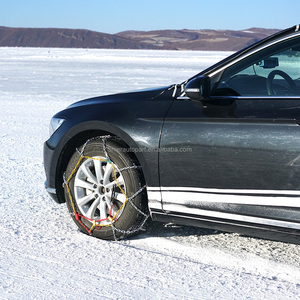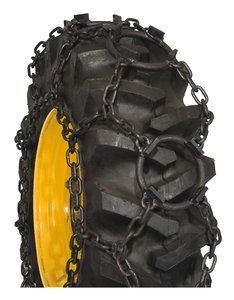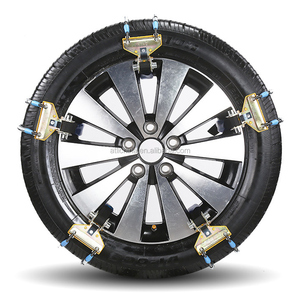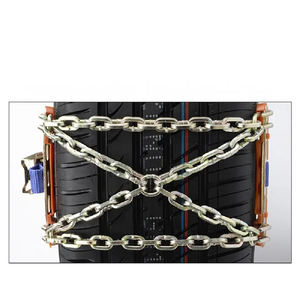(3899 products available)




























































































































































































































When snow falls and the road becomes slippery, the snow chain tire is a hero. It is a special tool that drivers put on their car tires to get a better grip on the road covered with snow or ice. The car will not slide or skid on the slippery road with these chains. Instead, it will hold the ground firmly like a shoe with a good sole on a wet floor. This way, the driver can control the car better, and the stopping distance is shorter, making winter driving much safer. There are different types of snow chain tires, and they include the following:
Link Chains
Link chains are the traditional type of snow chains. They are made of metal links that form a lattice over the tire's surface. The links provide a rough surface that grips the snow and ice. Depending on how the links are arranged, link chains come in different styles.
Spiked Chains
Spiked chains have metal spikes instead of links. The spikes dig into the ice for a firm grip. Spiked chains are excellent for icy conditions where extra traction is needed.
Fabric-Based Chains
Fabric-based chains are newer and lighter than traditional metal chains. They have a plastic or textile band with raised patterns that grips the road. Fabric-based chains are easy to install and work well in light to moderate snow.
Self-Adjusting Chains
Self-adjusting chains are designed to fit properly on tires without manual adjustment. They have automatic tensioning systems that keep the chain snug against the tire. This feature ensures optimal performance and reduces the risk of chain damage.
Dual-purpose Chains
Some chains are designed for both snow and mud. They usually have an aggressive tread pattern that works well in various slippery conditions. Dual-purpose chains offer versatility for areas with frequent winter and wet weather.
Lightweight Chains
Lightweight chains are ideal for vehicles with low power. They are smaller and lighter but still provide adequate traction. These chains prevent damage to tires and are suitable for occasional use in snowy conditions.
Before buying a snow chain for tires, check the specifications to ensure they meet business requirements and safety regulations. Here are some general specifications to expect:
Material
The tire chains are usually made of durable steel wire. Some have a zinc coating for added strength and corrosion resistance. This coating may make the chains more robust in harsh weather conditions. Additionally, some chains have alloy materials. These alloys are suitable for specific applications where conventional steel chains may not be appropriate.
Size
The chains come in various sizes to fit different tire sizes and vehicles. For instance, they have lengths ranging from 1.4 m to 2.2 m. The width also varies, with some chains measuring up to 3.5 cm. When buying snow chains, drivers should ensure they get the correct size for their tire width and diameter. This will guarantee a snug fit and optimal performance.
Link type
The chains have different link designs. This is meant to suit various applications and terrain conditions. For example, some have square links. These are ideal for icy and snowy roads. Other chains have V-shaped links. These links provide better grip on hard-packed snow.
Installation
Different chains have varying installation methods. Some may be simpler than others. For instance, some have quick-fitting mechanisms. They come with adjustable tensioning systems. This ensures proper fitting and tension. When choosing tire chains, opt for those with simple installation methods. This will make the workload easier when installing and removing the chains.
Proper maintenance of snow chain tires increases their lifespan and ensures optimal performance. Here are some maintenance tips:
Choosing the right tire chains for snow depends on several factors, including understanding the vehicle's needs, the type of snow and road conditions, and the chain's construction and fitment. Here are some of them:
It's very easy to install a tire snow chain, so manufacturers include instructions in the package. Here's how to do it:
These steps will help to install a snow chain for the tires successfully. They can be removed by reversing the installation process.
Always refer to the manufacturer's instruction manual when installing or removing chains for tires. The guide will provide more detailed steps and precautions to take when installing snow chains for tires.
Q1: How fast can one drive with tire chains?
A1: Generally, the recommended maximum speed when using tire chains is 30 mph. Driving faster can lead to equipment damage and safety risks due to reduced traction.
Q2: Can tire chains be used on all vehicles?
A2: While tire chains can be used on most vehicles, it's essential to ensure they are the correct size and type for the specific vehicle. This is particularly important for high-clearance or specialized vehicles.
Q3: How do snow chains for tires work?
A3: Snow chains for tires provide additional traction on icy or snowy roads. They work by physically breaking the ice and gripping the snow, which prevents the vehicle from slipping.
Q4: How often should tire chains be replaced?
A4: The frequency of tire chain replacement depends on usage, maintenance, and wear. Inspecting them regularly and replacing them when worn is essential to ensure optimal performance.
Q5: Are tire chains mandatory in some areas?
A5: In some regions, particularly those with severe winter conditions, tire chains may be required during winter months or when road signs indicate their use. It's essential to check local regulations.